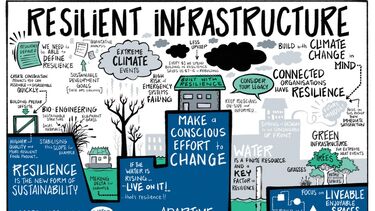The urgency of climate action in urban environments has never been more pressing. Cities are at the forefront of the global climate emergency, both as contributors to environmental degradation and as sites of potential resilience and adaptation. David Dodman’s recent discussions as part of ºù«Ӱҵ Urbanism’s Winter Programme shed light on how urban systems function, the risks they face, and the strategies required to mitigate climate impacts in an equitable manner. This blog post reflects on two public events held in ºù«Ӱҵ last week, where Dr. David Dodman shared his insights. The first was a public lecture exploring the connection between informality and climate change, and the second was a roundtable discussion with the Urban Institute, School of Geography and Planning and ºù«Ӱҵ Political Economy Research Institute on the World Cities Report, to which he contributed as an external author.
You can watch both the events on the Urban Institute’s Youtube channel here:
Climate change projections indicate that urbanisation will exacerbate rising temperatures, with disproportionate consequences for vulnerable communities. Historically, the Intergovernmental Panel on Climate Change (IPCC) has overlooked urban-specific challenges, focusing instead on governance and social science frameworks. However, cities are fundamental to climate adaptation, especially concerning water and food security, displacement, and migration.
Understanding risk as an outcome of urban form, society, economy, and governance is essential to shaping resilient futures. For example—Caribbean cities, much like many others across the Global South, have historically prioritised middle-class interests while neglecting the contribution and vulnerabilities of low-income communities. These cities struggle with the dual challenge of poverty and environmental degradation, yet their policies often fail to acknowledge the role of informal settlements and economies. The lack of inclusive environmental planning perpetuates socio-economic disparities, with infrastructure projects focusing on mitigation such as Jinja Materials Workshop in Uganda, rather than systemic resilience.
With 1.1 billion people currently living in ‘slums’—and projections suggesting this number will nearly double in the next 30 years—informal settlements are at heightened risk of climate-induced disasters. These communities face multiple threats from urban flooding, landslides, wind damage, and air pollution due to their location, lack of drainage infrastructure, and limited access to resilient housing. Moreover, informal workers—often engaged in precarious conditions—face compounded risks related to health and economic insecurity. Gender dynamics further shape vulnerabilities, with displacement disproportionately affecting women and marginalised groups.
Resilient infrastructure is essential, but it must be developed in a way that protects rather than displaces vulnerable communities. Informal settlements are often seen as vulnerable to climate change, but they are also hubs of innovation when it comes to adaptation. Residents, often with limited resources and without formal support, develop creative, community-led solutions to cope with environmental challenges—whether through water harvesting, waste recycling, or climate-responsive housing. At the same time, these communities typically have a much smaller carbon footprint compared to wealthier urban areas, as they rely less on high-emission infrastructure and consumption patterns. Recognizing both their resilience and their minimal contribution to climate change is essential for shaping more just and effective climate policies.
Climate-resilient projects have, in some cases, led to gentrification, forcing low-income groups out of their neighborhoods. Addressing land ownership rights and integrating informal economies into urban planning can help prevent this. Many outdated building regulations, rooted in colonial-era policies, also make affordable housing inaccessible, highlighting the need for reform.
A city’s ability to adapt to climate change depends on its physical and social infrastructure. Investments in healthcare, particularly for low-income groups, are crucial in responding to climate-induced health crises. Climate finance must also be more accessible. Currently, most funding depends on national and international partnerships, which often exclude local communities. Therefore we must start working towards creating more inclusive climate governance platforms that can help bridge this gap and ensure that solutions meet the needs of the most vulnerable.
In response to the questions posed by the audience, David made the point that incremental approaches are often ultimately the most transformative - while attempts at 'big bang' changes often leave underlying systems unchanged or create new environmental injustices. In reality, both approaches are necessary. Small changes can pave the way for larger systemic shifts, and policymakers must balance immediate needs with long-term sustainability. Crucially, responses must not place the burden of climate adaptation on already struggling communities.
As climate risks grow, cities must go beyond discussions and start taking action. The challenge is to balance urgency with effective and inclusive solutions. The future of urban resilience depends on policies that prioritize inclusion, sustainability, and justice. Cities must not only address climate risks but also rethink how they serve all residents—especially those most vulnerable to climate change.
The discussion brought about some thought-provoking action points for urban climate resilience. Key takeaways emphasised the need for transformative infrastructure such as Green building initiatives, Carbon offset programs etc, stronger climate governance, and financial accessibility. As ºù«Ӱҵ’s Professor of Climate Urbanism Vanesa Castán Broto - a co-author with David on the World Cities Report - concluded:
There has been a lot of dialogue about the situation, but what we need now is action. Act with hope, act without hope—but act.




